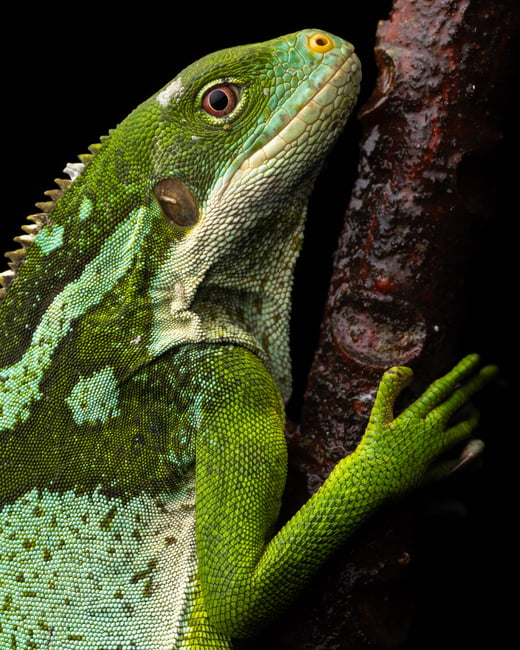تصوير الإغوانا الفيجي المهددة بالانقراض: تقرير الرحلة
Photographing Critically-Endangered Fijian Iguanas: A Trip Report
على بعد آلاف الأميال من أقرب أقاربها من الإغوانيات، وعبر المحيط الهادئ، تعيش الإغوانا الفيجي الرائعة والمهددة بالانقراض. لقد كنت محظوظًا بالعثور على اثنين من هذه الأنواع وتصويرهما خلال فترة وجودي في فيجي. نظرًا لندرتها الشديدة وتجمعاتها النائية، لا يتم نشر أي صور عالية الجودة تقريبًا للعينات البرية.
وفي تقرير الرحلة هذا، سأشارككم مغامرة التقاط هذه الصور النادرة، والتي يعد بعضها الأول من نوعه.
OM-1 + OLYMPUS M.8-25 مم F4 @ 10 مم، ISO 200، 1/400، f/8.0
Thousands of miles from their nearest iguanid relatives, and across the Pacific Ocean, live the marvelous, critically-endangered Fijian iguanas. I was fortunate to find and photograph two of these species during my time in Fiji. With their extreme rarity and remote populations, almost no high-quality photographs of wild specimens are published.
In this trip report, I will share the adventure behind capturing these rare images, some of which are the first of their kind.
 OM-1 + OLYMPUS M.8-25mm F4 @ 10mm, ISO 200, 1/400, f/8.0
OM-1 + OLYMPUS M.8-25mm F4 @ 10mm, ISO 200, 1/400, f/8.0
Photographing Critically-Endangered Fijian Iguanas: A Trip Report
على بعد آلاف الأميال من أقرب أقاربها من الإغوانيات، وعبر المحيط الهادئ، تعيش الإغوانا الفيجي الرائعة والمهددة بالانقراض. لقد كنت محظوظًا بالعثور على اثنين من هذه الأنواع وتصويرهما خلال فترة وجودي في فيجي. نظرًا لندرتها الشديدة وتجمعاتها النائية، لا يتم نشر أي صور عالية الجودة تقريبًا للعينات البرية.
وفي تقرير الرحلة هذا، سأشارككم مغامرة التقاط هذه الصور النادرة، والتي يعد بعضها الأول من نوعه.
OM-1 + OLYMPUS M.8-25 مم F4 @ 10 مم، ISO 200، 1/400، f/8.0
Thousands of miles from their nearest iguanid relatives, and across the Pacific Ocean, live the marvelous, critically-endangered Fijian iguanas. I was fortunate to find and photograph two of these species during my time in Fiji. With their extreme rarity and remote populations, almost no high-quality photographs of wild specimens are published.
In this trip report, I will share the adventure behind capturing these rare images, some of which are the first of their kind.
 OM-1 + OLYMPUS M.8-25mm F4 @ 10mm, ISO 200, 1/400, f/8.0
OM-1 + OLYMPUS M.8-25mm F4 @ 10mm, ISO 200, 1/400, f/8.0









تعليق